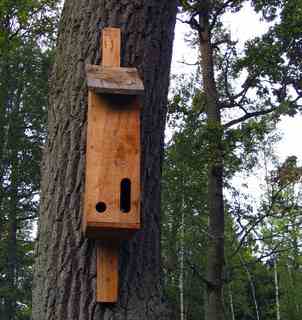By Sean Conway

Designed correctly and positioned well, a wooden nest can attract bats to roost, and to feast on the insects that devour your garden plants
In the dead of winter, it's not likely you're thinking about bats. And they're not thinking about you; they're hibernating. But now is a good time to be thinking about how you can attract this much-misunderstood flying mammal to your neck of the woods.
Why on earth would you want to invite bats to your backyard?
To begin with, consider their primary food source: insects. Bats spend most of the day holed up in their roosts resting quietly. At dusk they take to the skies and gorge on bugs, including those that damage agricultural crops and ruin perfectly good parties!
Bats have voracious appetites, and the little brown bat, a species found across much of the eastern half of the country can consume up to 1,000 flying insects in an hour. A nursing female can consume her weight in insects each night.
Not all bats eat insects; some dine on flower nectar, fruit and even fish and small amphibians. In fact, bats are critical for the pollination and seed dispersal of many plants. Nectar feeding bats spread pollen across large areas in places such as the Sonoran desert, and fruit eating bats help disperse seed across tropical forests.
All of which is to say that bats have a vital role to play in promoting biodiversity and preserving the balance of nature.
North America is home to 45 different species of bats, and chances are that bats live around your neighborhood. If they are, you're lucky. Bats are under a lot of pressure these days. A mysterious new illness called white-nose syndrome has been killing large colonies of hibernating bats in the Northeast, and it is spreading fast. In the past four years, an estimated 1 million or more bats of six different species have died.
One way we can help bats is to provide places for them to roost. Bat houses and kits to build them can be bought readily online and in some stores. You'll get your best results putting one up in late winter or early spring, when bats are migrating or emerging from hibernation.
On my television show, "Cultivating Life," Eric Pilotte showed me how easy it is to make a bat house using recycled lumber. Detailed instructions can be found at www.cultivatinglife.com (enter "bat house" in the search field).
Recycled wood is best to use because it provides a beautiful finish but also because it increases the odds of luring bats to live in the bat house.
Attracting bats is a mixture of know-how and luck. They like to live in a relatively small, enclosed space that will help capture their body heat, and they prefer to enter through a small opening in the base of the structure. Bat houses are best placed away from the home -- on a garage or barn -- at least 15 feet above ground. Hanging more than one bat house will increase the odds of attracting bats to roost.
Heat is an important factor in luring bats to roost in a bat house. In areas where the average summer temperature is below 85 F, a bat house should face south and southwest to take advantage of the warm sunlight. Where the average summer temperature is above 85 F, position it in a more northerly direction and out of direct sunlight.
Bats are important to us, and they do not need to be feared. You may find that inviting mosquito-loving bats to be your neighbors will not only reduce unwanted guests at your next cook out, it will improve the environment of your whole neighborhood.
© Cultivating Life by Sean Conway
AUTOS | HOBBIES | EDUCATION | FAMILY | FASHION | FOOD & RECIPES | HOME DECOR | RELATIONSHIPS | PARENTING | PETS | TRAVEL | WOMEN
Home & Garden - Bats: Our Fanged, Furry, Flying Friends